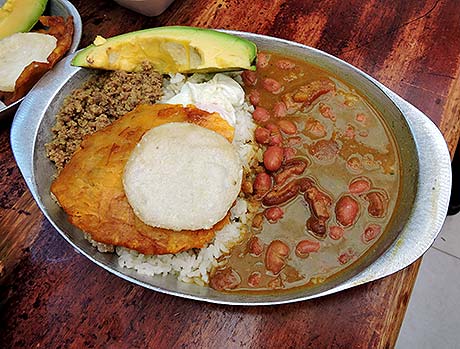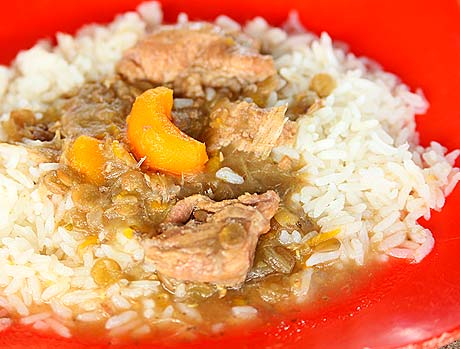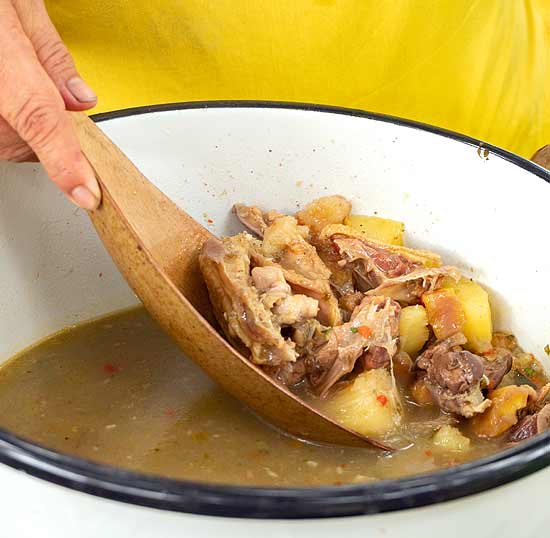
These emblematic Colombian dishes could suffer the consequences of climate change and rural exodus until they disappear
At six in the morning, Nydia Zoraida Caro lights her stove. When someone orders sancochos de gallina from her traditional food business, she fills a pot with water and mixes white meat, corn on the cob, arracacha and potatoes. Spices from her kitchen garden complement the dish.
Since she was a child, Nydia has been linked to the land, the truck farms, and the wood stove that she still uses to preserve the gastronomic tradition she learned from her parents in Ramiriquí, a municipality 90 miles north of Bogotá in the mountains of the Colombian Andes. In addition to sancochos, her kitchen produces various soups with yellow and white corn, guarapos, coladas. And when the melodies of the international corn festival (a festival held every July), are heard in Ramiriquí, Nydia highlights the culinary richness of her cuisine and of her region.
Those who know about cooking, as she does, know that to prepare a sancocho the cooks must go into the mountains to harvest potatoes and gather onions, coriander, and parsley. In addition, they must venture to warm lands to obtain green plantains. In the same terrain, they gather yuccas, then cut and peel them before adding them to the pot. In a sancocho, all the country's thermal floors are represented.
But this delicious tradition is under threat. Temperature changes and irregular rainfall threaten to reduce the availability of these ingredients grown in the mountains.
How about a bandeja paisa?
White rice, beans, plantains, corn arepas and animal protein (usually pork) are typical Colombian ingredients. But they are becoming more and more international, not necessarily because they are appreciated all over the world but because Colombia is increasingly dependent on imports, due to climate change and historical rural exodus -- factors that threaten the most traditional recipes of this diverse nation.
In 2018, for example, it was estimated that losses in the agricultural sector due to climate variability and extreme events reached about $41 million annually. According to the document 'Colombian agriculture: adapting to climate change', by the International Center for Tropical Agriculture (CIAT), “In the past decade, climate variations related to El Niño and La Niña have posed serious challenges to Colombian agriculture, demonstrating that many farmers are unable to effectively manage risk of and adapt to climatic fluctuations and shocks.”
The El Niño phenomenon, which is generally associated with a decrease in rainfall in relation to the historical monthly average and with an increase in air temperatures, especially in the Caribbean and Andean regions, meant losses of around $2 billion for Colombia between 1997 and 2016. For the second half of 2023, the situation could worsen as El Niño is expected to emerge again.
In addition, in the long term, an average annual temperature increase of 2.5°C is forecast for Colombia by 2050, and precipitation is likely to increase by 2.5% by mid-century. But in some regions, it will decrease. The report also notes that "without accelerated adaptation, climate change could result in soil degradation and loss of organic matter on the Andean slopes, flooding on the Caribbean and Pacific coasts, declining habitats for coffee, fruit crops, cocoa and bananas, changes in the prevalence of pests and diseases, glacier melt and water stress."
Differences in average annual temperature and precipitation in the period 2071-2100 with respect to the reference period 1976-2005.
The 2011-2100 climate change scenarios elaborated by IDEAM (IDEAM, et al., 2015) show that the whole country would be affected by climate change. However, the expected increase in temperature, as well as the precipitation behavior, will not be the same for all regions of the country. Chart 2 summarizes the observed and projected effects of climate change on the agricultural sector in Colombia.
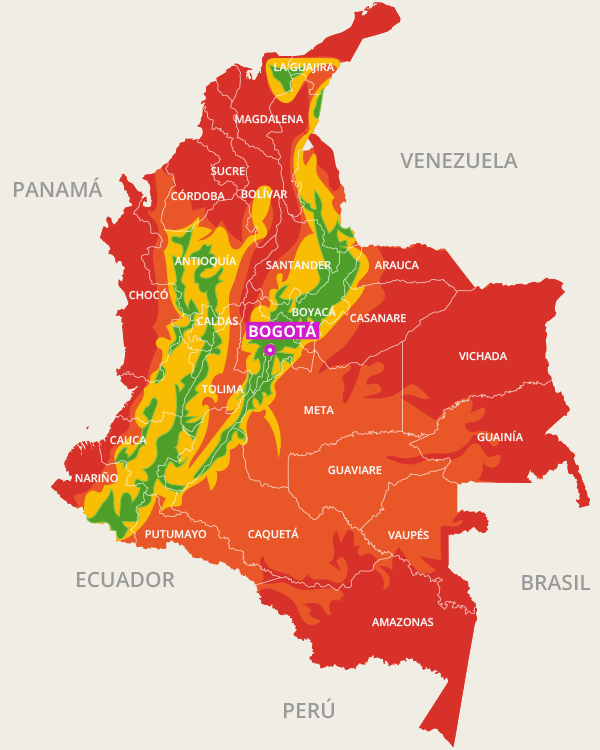
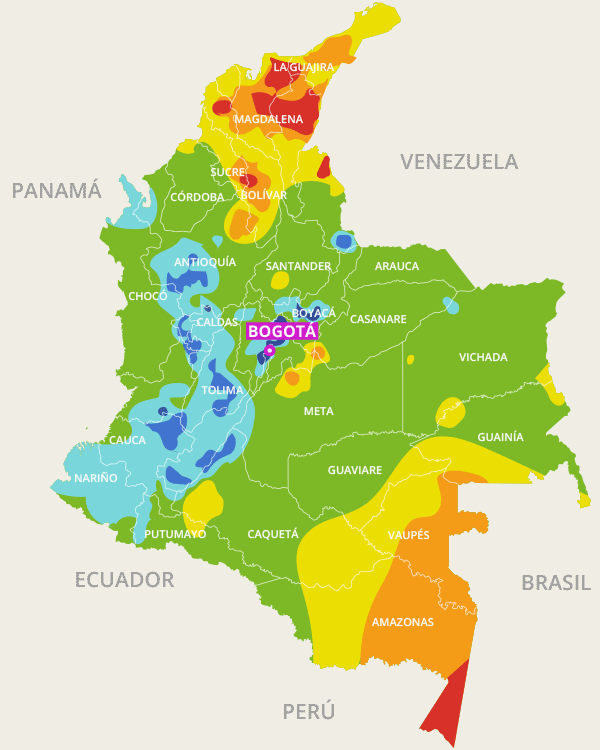
Source: IDEAM
Climate threats
Miguel Durango, leader of a farmers' initiative in the Colombian Caribbean, emphasizes the lack of a comprehensive water policy and effective governance to address risks. "We don’t want to get caught with our pants down when we face the El Niño phenomenon that is coming," he says from the Caribbean. “Community aqueducts and water management are needed to cope with droughts. We need irrigation and drainage systems.”
At risk is one of the South American country's favorite foods: beans.
In Colombia, more than 15 varieties of this legume are marketed, all of them vulnerable to extreme climates. Excessive rainfall and drought affect their production. In 2022, during the La Niña phenomenon, many farmers stopped planting due to excess rainfall during the growing season.
The decline in planting was felt in the country’s food supply. According to Colombia's National Federation of Cereal and Legumes Producers (FENALCE), 168,711 tons of beans were sold in 2022, of which 53,381 tons were imported, marking an increase in imports according to data from the Ministry of Agriculture.
That food is not produced by us, but offered to us by a third party is a very serious dependence and a very risky vulnerability to food security," says Henry Vanegas Angarita, manager of the institution. "The fact that we depend on imports is as if our neighbor were buying groceries for us," he adds.
The challenge of bean production in Colombia is compounded by the lack of technology and the ongoing impact of climate change. This, together with the internal armed conflict, international conflicts, and the effects of the pandemic on the importation of agricultural inputs, has contributed to an increase in food prices. By March 2023, the price of red beans in Bogota increased by 81.84%, reflecting the vulnerability of indigenous products, which lack government support.
In Colombia, beans are imported because the national production is in the hands of small farmers who produce 80% of the food consumed in the country. They grow it in different thermal floors, but they have no technical support or commercialization channels to guarantee their sustainability, and therefore, in the face of inclement weather, they cannot plant.
"Also, they often do not own land and therefore cannot access support," explains Sonia Gallego, food engineer and coordinator of the post-harvest and food product development area of the International Center for Tropical Agriculture (CIAT) and the Alliance of Bioversity International.
Corn is in the Colombian DNA
Corn, a pillar of Colombian gastronomy, goes beyond the white corn arepa in the bandeja paisa. Each region of the country has its own version of the arepa, thanks to the corn diversity. According to anthropologist Luis Vidal, professor at the University of Antioquia, "corn and beans are in our DNA and connect us to our land.”
However, figures from the National Federation of Cereal and Legumes Producers (FENALCE) reveal a concerning dependence on corn imports. In 2022, roughly 1 million tons of white corn were sold in Colombia, but 35% -- some 378,645 tons -- were imported. That same year, 1.2 million tons of yellow corn were produced, but 6.1 million tons were imported.
Corn, which is vulnerable to extreme weather events such as heavy rainfall, faces a challenging future. According to a study by CIAT and the Alliance of Bioversity International, reductions in corn yields are expected in all corn-growing regions of the country due to climate change. Variations in temperature and rainfall impact the growth and productivity of the crop.
By 2050, corn-producing areas are projected to experience significant temperature changes. By 2030, productivity could be reduced as much as 30%, the study says. These threats could also increase dependence on corn imports from the United States, which, paradoxically, expects increased yields due to climate change.
Corn is not only essential for human consumption, but also plays a key role in animal nutrition, indirectly affecting poultry, pork, and other protein sources before they reach our tables. The vulnerability of corn could generate a negative ripple effect on supply chains that ultimately affects our food security.
Banana plantation challenges
The banana is also facing challenges due to increased rainfall, which has led to a significant increase in prices. This popular fruit is part of the basic family food basket and plays a crucial role in the food security of Colombians. In 2022, Colombia experienced food inflation of 29%, with bananas leading the price increase, followed by chicken.
Globally, Colombia ranks as the fifth-largest banana producer. Although the average yield per acre has increased in recent years, reaching 8.3 tons per 2.5 acres in 2019 from 7.3 tons per 2.5 acres in 2007, a decrease in planted areas and production occurred in 2018 due to adverse weather conditions in various areas of the country.
Potatoes, on the rise
Meanwhile, potatoes are growing at higher elevations in the mountains due to the increase in temperature. They have reached the heights of the water reservoirs (paramos) that provide 70% of the country's water and that should remain intact if we want to guarantee the humidity of our food. But these ecosystems are being increasingly reduced by crops. If tubers continue to grow, soon there will be no water left to plant them.
According to data from the Institute of Hydrology, Meteorology and Environmental Studies (IDEAM), climate projections indicate an increase in the average temperature in some potato-producing regions, with a range of 0.51 to 1 °C for the period 2011-2040. In addition, an increase of 2.5 °C by 2030 and 2.9 °C by 2050 is expected in potato-producing areas, mainly in the department of Cundinamarca, in the heart of Colombia.
This climate change translates into lower potato crop yields, further impacted by irregular rainfall patterns, including rainfall concentrations and long periods of drought. In the department of Cundinamarca, yields are expected to decline over the next decade, with losses ranging between 5% and 35% compared to the 2000-2010 period.
In addition, pests and diseases are expected to increase in the crops in growing regions that are less than 1.5 miles above sea level. These concerns are compounded by the risk of the El Niño phenomenon, which could trigger water stress in crops, further reducing yields.
Small producers, who make up 45% of national production, are especially vulnerable due to their limited adaptive capacity. "In general, potato prospects for Colombia are not encouraging. Yield losses are projected in large producing areas and a migration of the crop's ecological suitability to areas of high environmental relevance such as the paramos," the study concludes.
Defending Food
Action by the different sectors is imperative to seek effective adaptation to the new climate scenarios. Since 2018, Colombia has implemented agroclimatic roundtables in its states, a collaboration between academics, the government, and producer associations. According to Yenny Fernanda Urrego, agricultural engineer and professor at the University of Tolima, these roundtables are held monthly to analyze climate forecasts, including phenomena such as El Niño and La Niña. From these meetings, an agroclimatic bulletin is produced and distributed in various media so farmers can make informed decisions to protect their crops.
But this measure isn’t enough. The bulletins do not reach all farmers, especially those in remote areas who may be most in need of support.
Experts suggest that a more effective strategy lies in the rich biodiversity of Colombia, the second most biodiverse country in the world.
Montes de María, in the Colombian Caribbean, is a success story. In the municipality of Tolúviejo, in the state of Sucre, the farmers’ association Asocomán has established small fields with more than 20 edible species which provide healthy food and generate income for 24 families.
This sustainable model was created through an initiative of the United States Agency for International Development (USAID), which sought to provide economic alternatives to farmers while protecting the forest. Farmers have learned to take advantage of each fruit, to take care of the environment, to calculate production costs, and access fair markets. In the past, many fruits were wasted because the farmers had no one to sell them to. Today, in alliance with more than 20 restaurants throughout the country, they have established a 100% sustainable process.
Participating restaurants create their menus based on available produce from the association, rather than the other way around, and organize festivals to take advantage of surplus crops.
Jaime Rodríguez, founder of the Celele restaurant in Cartagena, explains that this project pays farmers to harvest food, thus valuing what is in the ecosystem and avoiding cutting down trees and crops that could be affected by climate variations. This approach has resulted in unique culinary creations, such as the Caribbean flower salad and the orejero flan, which are not only delicious but use local products.
The main challenge is adaptation -- exploring which crops can restore soils and which are resistant to droughts and heavy rains. In addition, the focus is on recovering native seeds that allow soil adaptation in an agroecological manner.
Miguel Durango, agronomist and project leader, stresses the importance of this initiative being sustainable in environmental, social and economic terms. Today, more than 16 varieties of banana are produced in these areas, and in the case of mango, there are about 36.
A bunker for biodiversity
In a world where climate change threatens food security, Colombia has become a haven for vital agricultural diversity. It is home to one of 15 germplasm banks, known as 'Seeds of the Future', which houses an impressive collection of more than 67,000 varieties of beans, cassava, and tropical forages, with more than 36,000 types of beans.
The genetic diversity of plant species fundamental to agriculture and food is safeguarded, and many of them are resistant to extreme temperatures, droughts, and floods. Cassava, for example, is a hardy and essential crop for resource-constrained farmers who cannot fertilize their land.
Beans, on the other hand, are important due to their diversity and their role as a staple in many diets. As agriculture became more industrialized in the last century, high-yielding varieties were prioritized, leading to a loss of diversity.
The 'Seeds of the Future' bank, managed by the International Center for Tropical Agriculture (CIAT) and the Alliance of Bioversity International, is located in the city of Palmira, near Cali, in the Colombian Pacific.
Paradoxically, this safeguard has come to institutionalize a task that farmers and indigenous people have been doing since ancient times, but which had not seemed to be important until today.
"Rural communities have preserved diversity and that is what we must maintain. It will be the solution when the situation becomes critical," says Eduardo Martínez, agronomist and owner of the renowned Mini-Mal restaurant in Bogotá, who leads a process of environmentally, socially and economically sustainable food production in his restaurant with communities in the Amazon and Colombia's Pacific Coast.
Now more than ever, the situation demands that Colombians recover community and ancestral practices along with scientific knowledge and public policy in order to adapt to the new climate reality.
Thinking in the Rain
Carlos Toto Sánchez, gastronomic researcher and professor at the Universidad de la Sabana, points out that the loss of food sovereignty and security is equivalent to loss of identity and culture.
The intrinsic relationship between land and food is part of our essence. Food not only nourishes our bodies, but also educates, regulates human relationships and builds community because most of our traditional dishes are designed to be shared, not to be consumed in solitude. As Sánchez points out, "food is a fundamental pillar of the culture of any community and is intimately connected to its land and its history. To lose a fruit or vegetable is to lose part of our identity and history.”
Professor Vidal explains that traditional food connects Colombians with the surrounding landscape and cultural roots. The tradition of having a claro de maíz (a corn-based beverage) in a totuma highlights the importance of having a bond with past generations and with our history. "Through corn we connect with the land," he says.
Climate change has disoriented farmers who face unpredictable changes in rainfall patterns and other extreme weather events. As a result, many are giving up on agriculture.
“We changed the climate and the cycles of animal reproduction, flowering and insect pollination,” says Vidal. “We changed the climate and it ended up changing us.”











































